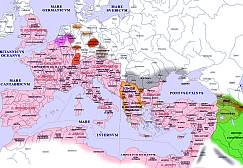

An Online Encyclopedia of Roman Emperors
Valentinian III (425-455 A.D)
Ralph W. Mathisen
University of South Carolina
Placidus Valentinianus, later the emperor Valentinian III, was born in 419, the son of the emperor Honorius' sister Galla Placidia and the patrician, later emperor, Constantius. He was the brother of Justa Grata Honoria. In the early 420s he was proclaimed Most Noble (Nobilissimus) by his uncle Honorius, but neither this title nor his father's emperorship were initially recognized in the east. After his mother's falling out with Honorius, the young Valentinian accompanied her and his sister to exile at the court of his cousin Theodosius II (402-450) at Constantinople. The eastern attitude toward Valentinian changed in 423, when the usurper Johannes seized power in the west. Valentinian was first reaffirmed as Nobilissimus in 423/424, and then was named Caesar (junior emperor) in 424. In the same year he was betrothed to his cousin Licinia Eudoxia, the daughter of Theodosius II. In 425 he was proclaimed Augustus at Rome after the defeat of Johannes, and in 437 he returned to Constantinople for his marriage. A partially extant poem in honor of the nuptials was written by the poet Merobaudes.
In the early years of his reign, Valentinian was overshadowed by his mother. After his marriage in 437, moreover, much of the real authority lay in the hands of the Patrician and Master of Soldiers Aetius. Nor does Valentinian seem to have had much of an aptitude for rule. He is described as spoiled, pleasure-loving, and influenced by sorcerers and astrologers. He divided his time primarily between Rome and Ravenna. Like his mother, Valentinian was devoted to religion. He contributed to churches of St. Laurence in both Rome and Ravenna. He also oversaw the accumulation of ecclesiastical authority in the hands of the bishop of Rome as he granted ever greater authority and prestige to pope Leo the Great (440-461) in particular.
Valentinian's reign saw the continued dissolution of the western empire. By 439, nearly all of North Africa was effectively lost to the Vandals; Valentinian did attempt to neutralize that threat by betrothing his sister Placidia to the Vandal prince Huneric. In Spain, the Suevi controlled the northwest, and much of Gaul was to all intents and purposes controlled by groups of Visigoths, Burgundians, Franks, and Alans. In 454, Valentinian murdered his supreme general Aetius, presumably in an attempt to rule in his own right. But in the next year, he himself was murdered by two members of his bodyguard, ex-partisans of Aetius.
Although Valentinian was ineffectual as a ruler, his legitimate status and connection to the old ruling dynasty provided a last vestige of unity for the increasingly fragmented Roman empire. After his death, the decay of the west accelerated. The different regions of the west went their own way, and the last several western emperors, the so-called "Shadow" or "Puppet" Emperors, not only were usually overshadowed by one barbarian general or other, but also were limited primarily to Italy.
Editions:
Primary sources: For legislation issued by Valentinian, see the Constitutiones sirmondinianae and the Novella Valentiniani published in the Codex Theodosianus, see also the Codex Justinianus.
Critical Studies:
Barnes, Timothy D. "Patricii Under Valentinian III." Phoenix 29(1975): 155-170
Ensslin, Wilhelm "Valentinians III. Novellen XVII und VIII von 445." Zeitschrift der Savigny-Stiftung für Rechtsgeschichte, Römanistische Abteilung 57(1937): 367-378
Musumeci, Anna Maria, "La politica ecclesiastica di Valentiniano III." Siculorum gymnasium 30 ns(1977): 431-481.
Selb, Walter, "Episcopalis audientia von der Zeit Konstantins bis zur Nov. XXXV Valentinians III." Zeitschrift der Savigny-Stiftung für Rechtsgeschichte, Römanistische Abteilung 84(1967): 162-217.
Comments to: Ralph W. Mathisen.
Updated: 1 June 1999
For more detailed geographical information, please use the DIR/ORBAntique and Medieval Atlas below. Click on the appropriate part of the map below to access large area maps.
